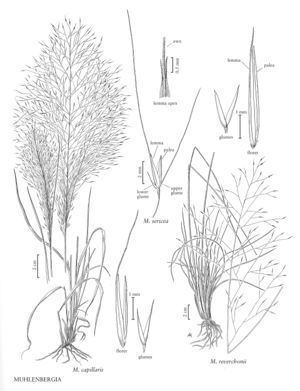Difference between revisions of "Muhlenbergia sericea"
FNA>Volume Importer |
FNA>Volume Importer |
(No difference)
| |
Revision as of 19:24, 24 September 2019
Plants perennial; cespitose, not rhizomatous. Culms 70-140 (160) cm, erect from the base, not conspicuously branched; internodes mostly glabrous, sometimes puberulent below the nodes. Sheaths glabrous or puberulent, sheaths rounded near the base, rarely becoming fibrous at maturity, not becoming spirally coiled when old; ligules 4-8(10) mm, membranous, firm, strongly decurrent, obtuse; blades 35-100 cm long, 1-3 mm wide, usually involute, smooth abaxially, scabrous adaxially. Panicles 20-60(70) cm long, 15-30(40) cm wide, longer than wide, diffuse; primary branches 2-20 cm, capillary, diverging 30-100° from the rachises, naked basally, lower branches with 5-20 spikelets; pedicels 4-50 mm, longer than the spikelets, capillary, divergent, stiff or flexible. Spikelets 3-5 mm, mostly purplish. Glumes subequal, (0.3)1-2 mm (excluding the awns), less than 1/2 as long as the lemmas, glabrous; lower glumes 1-veined, awned, awns 0.5-10 mm; upper glumes 1-veined (rarely 3-veined), acute to acuminate, often erose, awned, awns 2-25 mm; lemmas 3-5 mm, lanceolate, calluses shortly pubescent, apices acuminate, with 2 setaceous teeth, teeth 1-5 mm, awned from between the teeth, awns 8-35 mm, clearly demarcated from the lemma bodies; paleas 2-4.5 mm, lanceolate, acuminate, veins usually extending into awns to 2 mm; anthers 1.5-2 mm, purple. Caryopses 2-2.5 mm, narrowly elliptic, brownish. 2n = unknown.
Discussion
Muhlenbergia sericea grows in sandy maritime habitats on the barrier islands and in coastal woodlands of the southeastern United States, at elevations of 0-50 m. It is available as an ornamental, sometimes under the name 'Purple Muhly'.
Selected References
None.
